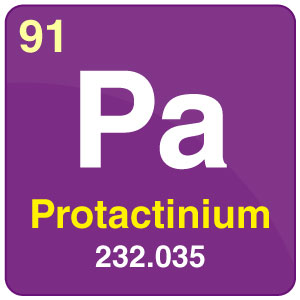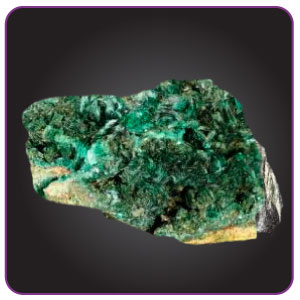Protactinium (Pa)

| Symbol | Pa |
| Atomic Number | 91 |
| Atomic Mass | 231.0359 g.mol -1 |
| Discovered by | K. Kajans and O.H. Gohring in 1913 |

What is Protactinium?
Protactinium is a shiny, radioactive and silvery element present in the periodic table with the atomic number 91 and the symbol Pa.
Table of Contents
- Chemical Properties of Protactinium
- Applications of Protactinium
- Protactinium Properties
- Certain Facts About Protactinium
Chemical Properties of Protactinium
| Group | Actinides | Melting point | 1572°C, 2862°F, 1845 K |
| Period | 7 | Boiling point | 4000°C, 7232°F, 4273 K |
| Block | f | Density (g cm−3) | 15.4 |
| Atomic number | 91 | Relative atomic mass | 231.036 |
| State at 20°C | Solid | Key isotopes | 231Pa |
| Electron configuration | [Rn] 5f26d17s2 | CAS number | 7440-13-3 |
| ChemSpider ID | 22387 | ChemSpider is a free chemical database | |
Applications of Protactinium
- Being a rare element, protactinium exhibits high radioactivity and toxicity. Hence, it does not have any practical applications but is used as a topic for research.
Protactinium Properties
- Protactinium metal is a shiny, radioactive and silvery metal that degrades slowly in the presence of air to form oxides. This metal has around five isotopes with their mass numbers ranging between 212 to 238 and protactinium 231 is considered to be the most stable isotope with a half-life of about 32,760 years. This isotope is produced by the decay of element uranium 235 by emitting gamma radiation.
- Protactinium is known to be one of the most expensive and rarest naturally occurring elements on the earth. The metal occurs about three parts per trillion and sometimes in parts per million in uranium ores. The uranium processing obtains it as a by-product. The element was discovered by two persons named K.Kajans and O.H. Gohring in the year 1913.
- As a metal, protactinium is in a dense form and silvery-gray having a bright metallic look. It is superconductive in nature at temperatures below 1.4K. It reacts with oxygen, inorganic acids, and water vapor forming its compounds. Some of its compounds are also colored. In the solid compound state, protactinium is the most stable in its oxidation state of +5. Also, it exists in the +4 oxidation state, even +3, +2 oxidation states. In solution state, the +5 oxidation state rapidly gets hydrolyzed by combining with the hydroxide ions forming soluble and insoluble hydroxy-oxide solids.
Certain Facts About Protactinium
- Protactinium is considered to be toxic when ingested into the body. It affects the lungs and the gastrointestinal tract.
- The leading causes of exposure of the body to this element are through the intake of food and water and also through the inhalation of contaminated dust which consists of protactinium.

Comments